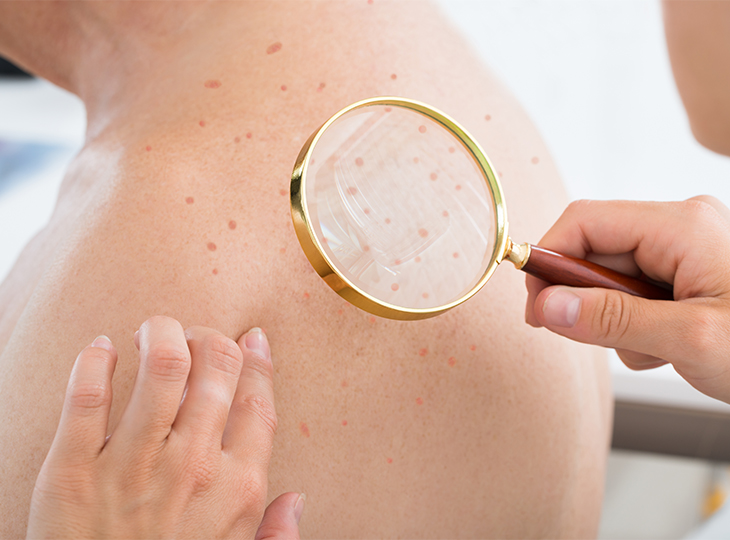Tues: 8:30am - 3:00pm
Wed: 12:00pm - 6:00pm
Thurs: 8:30am - 3:00pm
Fri: Closed
Sat: 8:30am - 12:30pm
Sun: Closed
Greenvale, NY 11548
Full Body Skin Exams: Why a Regular Screening is so Important


You will probably be the first person to notice something different about your skin. Skin is the largest organ of your body and you live in it, so you are almost certain to see changes before anyone else.
Determining the precise nature of the condition may require an examination by your dermatologist. Many skin conditions are easily identified. Acne, psoriasis, hives, and rosacea are common examples. Then there are moles, sun spots and other blemishes that appear on your skin or begin changing their shape, size and appearance. What does this mean? If the mole or blemish is on your back will you even notice?
This is why a full body skin exam should be performed regularly by a dermatologist. It could save your life.
Since November is National Healthy Skin Month, now is a good time to take a closer look at your skin, and perhaps have a partner check areas on your body that are difficult for you to see. If you do notice anything different or unusual, schedule an appointment with your dermatologist to have it checked.
A full body skin exam will identify suspicious growths or spots that could be symptoms of skin cancer. The exam is sometimes called a “skin cancer screening” and is essential for detecting and treating skin cancer early on.
Skin cancer is the most common form of cancer in the United States and impacts about 20% of the population. The American Academy of Dermatology started National Healthy Skin Month expressly to raise awareness of skin cancer and encourage people to be proactive about their skin health.
There are three main types of skin cancer: basal cell carcinoma, squamous cell carcinoma and melanoma. While each type looks different, the most common warning sign of any skin cancer is a change on the skin, such as a new growth or a visible change in an existing growth or mole, including color.
You may not feel changes in your skin. It takes a visual inspection. If you cannot see them or do not notice these changes, your health could be at risk.
How long does the exam take?
Full body skin exams typically last no more than 20 minutes. During that time, your dermatologist will examine your skin from your scalp to your toes and the bottom of your feet. In some cases, depending on the findings, your dermatologist may need to perform a biopsy, which involves removing a small piece of skin for microscopic inspection and testing. A biopsy is a virtually pain-free procedure that takes only a few minutes. The exam itself is completely painless.
What should I wear to the exam?
Anything you wish. The medical team at your dermatologist’s office will give you a gown to change into before the exam. That said, you should remove all polish from your fingernails and toenails so that your dermatologist can inspect those areas. Also, don’t wear any makeup to the exam. Remove jewelry, bandages and anything else that might be covering an area of your skin. Wearing your hair down for the exam will make it easier to examine your scalp.
What happens during the exam?
Your dermatologist will examine all areas of your skin under bright light, using a magnification tool known as a dermatoscope for a closer look. The dermatologist will also ask questions about any changes you may have noticed in your skin, your family’s medical history, the frequency of your sun exposure and the steps you take to protect your skin. You’ll likely be asked whether you use tanning beds regularly or if you’ve experienced blistering sunburns. Some occupations, such as landscaping and construction, can put people at higher risk for skin cancer because of the daily sun exposure. Your answers will help the dermatologist assess your personal risk of skin cancer.
People with lowered immune systems, a family history of skin cancer or who have prolonged, daily outdoor exposure to the sun, and organ transplant recipients are at higher risk of developing skin cancer, according to The Cleveland Clinic. A history of tanning bed use is also a risk factor.
The good news is, virtually all forms of skin cancer respond to treatment and can be cured successfully – if detected early enough. This is why a full body skin exam is so important.
How often should I get an exam?
Medical professionals recommend annual full body skin exams. People who are assessed at high risk for skin cancer or have a history of skin cancer may need to schedule more frequent exams. Your dermatologist can recommend the right course of action for you. Also, if you notice any changes in your skin, don’t delay, make an appointment with your dermatologist right away.
Let Walk-in Dermatology Take Care of You
If you have concerns about any skin condition and need dependable answers, you don’t have to wonder, worry or wait. Walk-in Dermatology is here to keep you healthy. Our team of dermatologists and experienced healthcare staff will address your concerns and provide the necessary care for all your skin conditions. We can set up a Video Visit and even prescribe medications remotely, or you can schedule an appointment with us online. The choice is yours. But don’t wait until the problem gets worse. Contact us today.








